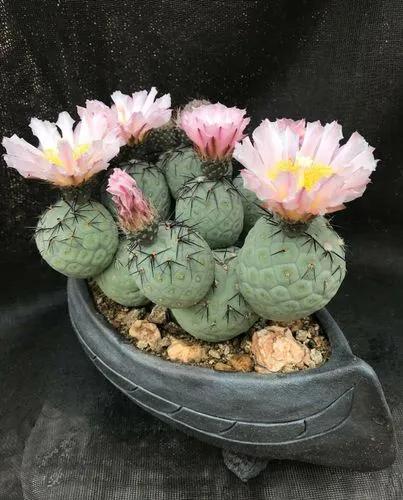Small flattened cactus that can be found very clumped in habitat.
Gymnocalycium Calochlorum Care
Gymnocalycium Calochlorum



How to Care for the Plant

Water

Allow the soil mix to become nearly dry between waterings, but then water thoroughly. Good drainage is essential since leaving the plant sitting in water can lead to root rot. During the summer months, the plant might need frequent watering, especially if it has been moved outside. Plants in small pots will only need weekly watering. Watering in the winter months is unnecessary, but mist the plant occasionally.

Fertilizer

You do not need to regularly fertilize your ruby ball cactus plant, but you should dose it with a cactus fertilizer every month during its growing season (April to September). Suspend feeding during the dormant winter period.

Sunlight

The red ball tops are tolerant of more shade than many cacti and dislike direct sunlight. By contrast, the stock green cacti on the bottom are often light-lovers. Look for a bright area, but not so bright that the color of the top begins to wash out.

Soil

A rich, fast-draining cactus mix with a low pH is ideal. Make sure the soil meets the needs of the host cactus on the bottom.

Temperature

Ideal conditions for the rootstock and the upper scion portion may not be the same. The upper ruby ball scion is hardy in USDA plant hardiness zones 11 through 12, while some of the rootstock species (such as night-blooming cereus or blue myrtle) are hardy in zones as low as 8 or 9. During the winter, the recommended temperature range is between 50 and 60 degrees Fahrenheit.1 It is possible for borderline temperatures to cause the ruby red portion to die while the rootstock survives. Like most cacti, this plant prefers low humidity levels.

Container

Repot as needed, preferably during the warm season. To repot a cactus, make sure the soil is dry before repotting and then gently remove the pot. Knock away the old soil from the roots, making sure to remove any rotted or dead roots in the process. Treat any cuts with a fungicide. Place the plant in its new pot and backfill with cactus-mix potting soil, spreading the roots out as you repot. Leave the plant dry for a week or so to reduce the risk of root rot and then begin to water lightly.
Discover more plants with the list below
Popular articles






